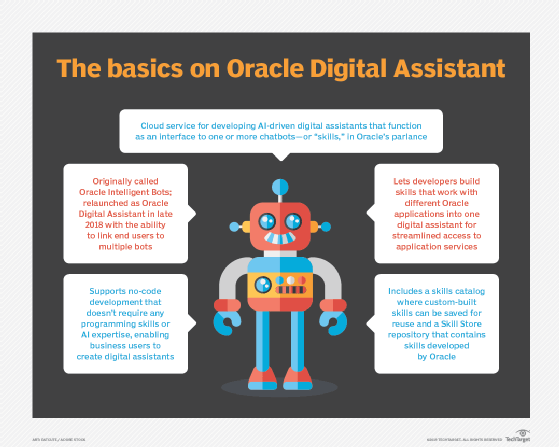Oracle Digital Assistant unifies use of enterprise chatbots
With Oracle Digital Assistant, users are able to create digital assistants with multiple chatbots that handle different tasks to help increase worker productivity.
Oracle Digital Assistant is a cloud service that offers what Oracle describes as the next generation of enterprise chatbots. Launched in October 2018, it provides a platform for building and deploying AI-enhanced digital assistants to help end users work more productively when using Oracle applications.
The service is built on the Oracle Cloud Infrastructure, Oracle's IaaS technology. As with its other cloud services, Oracle manages the platform components in addition to patches, backups and other administrative functions. This allows customers to focus on using the tools included with the platform to develop, implement, maintain, monitor and analyze digital assistants that can orchestrate access to multiple chatbots with different duties.
Also sometimes referred to as ODA, Oracle Digital Assistant is an updated version of what was originally known as Oracle Intelligent Bots. Oracle has incorporated AI into the platform to provide natural language processing capabilities that enable end users to engage with conversational interfaces. As a result, chatbot developers can build Oracle bots that are able to understand context, derive intent and proactively automate routine tasks.
End users can access the digital assistants through popular messaging services such as Siri, Alexa, Slack, WeChat and Facebook Messenger. Oracle Digital Assistant can also be configured to hand over conversations to a human customer service agent in Oracle Service Cloud if a digital assistant isn't trained to handle situations that arise. In such cases, the agent has full visibility into the preceding conversation with the assistant, so users don't have to repeat themselves.
Digital assistants combine chatbot skills
When building digital assistants, developers add "skills" that are specific to Oracle applications -- for example, its customer experience, ERP and HR software applications. According to Oracle, a skill in this case is an individual chatbot focused on a specific task, such as making reservations, ordering goods or updating contact information. Developers can build a mix of skills into a digital assistant, which greets users, routes their requests to the right skills and handles interruptions to the workflow.

Organizations can either create their own skills and save them for reuse in a skill catalog that's part of the Oracle Digital Assistant service or use skills from the Skill Store, a centralized repository of prebuilt skills designed to work with Oracle's SaaS applications.
Digital assistants can be programmed to carry out any tasks that application APIs allow them to perform. By using custom components, developers can create modules that use the APIs to fetch information or perform transactions on the target applications. The modules are automatically invoked during the dialog flow as users interact with the digital assistants.
A single digital assistant can support skills connected to different Oracle applications. As a result, users need to interact with only one digital assistant to engage with multiple enterprise chatbots and cloud application services simultaneously instead of a separate assistant for each application.
Development with Oracle Digital Assistant
The Oracle Digital Assistant platform supports no-code development with a web-based, drag-and-drop interface, which allows business subject matter experts to build and train digital assistants using visual and declarative tools without needing specialized development or AI skills.
For example, to create the initial digital assistant interface, developers need only click a few menu items in the platform's UI. Once that has been done, the necessary skills that are available in the skill catalog or store can be retrieved and added. Cloning or importing existing skills and building custom skills from scratch involve a few more steps, but still no coding.
Regardless of how a skill is created, it must be given an invocation name so it can be explicitly invoked by digital assistant users who want to access that specific skill. Developers must also include example utterances to help Oracle Digital Assistant's intent engine identify when users want to invoke a skill.
When a user engages with a digital assistant, it evaluates the user's input and decides how to proceed by weighing automatically generated confidence scores against a set of routing parameters. The conversation can be routed to a particular skill; a different place in the dialog flow; or a built-in system intent, such as the digital assistant's exit and help functions. In addition, the digital assistant can pause an ongoing conversation to respond to a non-sequitur question and then return to the original thread.
Oracle Digital Assistant also offers developers built-in analytics to help them monitor the use and performance of previously deployed digital assistants. For example, the analytics tools can identify execution paths, track conversation trends, measure intent accuracy and provide other real-time insights. They also suggest performance tuning options designed to help improve the efficiency of digital assistants.








